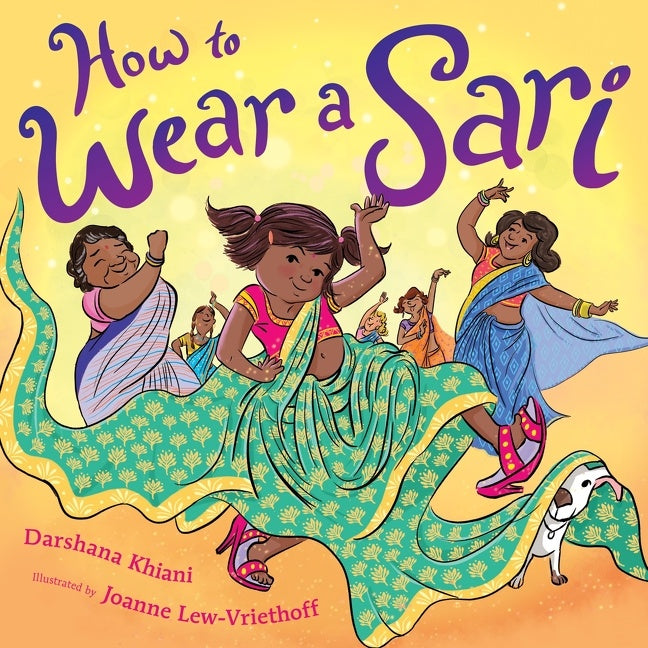interview by Kristi Wright
Here at KidLitCraft.com, both Anne-Marie and I have been privileged to be critique partners and friends with Darshana Khiani for quite a few years now. She’s thoughtful and passionate about writing picture books…and always curious–curious to learn more and curious about experimenting with the art form. I’ve learned so much from her critiques! It’s been a real pleasure to watch her grow her craft in her journey to becoming a published author. We’re excited to celebrate her debut picture book, How to Wear a Sari (fabulous illustrations by Joanne Lew-Vriethoff) which came out last June. With two more picture books coming out in 2023, we are quite sure this is the beginning of an illustrious career in children’s books. – Kristi
KidLit Craft: How To Wear a Sari is told in second-person, with a mischievous narrator who encourages the main character to dress up in her mom’s sari. What challenges did you run into writing this in second-person? What were the benefits? Did you try the story in other ways?
Darshana Khiani: While writing How to Wear a Sari I don’t remember having much challenge with writing in 2nd POV. However, now that I am trying to write a sequel and may need to have two characters in the activity it’s proving to be a bit challenging, mainly because I didn’t have dialogue before and would like to have it now in the sequel. So it’s probably not a limitation with the 2nd POV but about the boundaries I set with the first book. With 2nd POV, it is harder to express interiority and character feelings. I think the 2nd POV is more engaging and it is easier to pull in the reader. An editor requested an R&R (revise & resubmit) and wanted more description and background to connect the pieces of the character’s problem, her solution, and how that fit within Indian culture. In order to address this I wrote a draft in 1st POV but my agent felt the 2nd POV was fresher. So she continued sending the original version on submission.
KLC: Do you typically start with character, problem, theme, setting, form? How do you usually enter a story?
DK: That is a great question. I’ve never done an analysis of my stories, but I believe I usually enter through a combination of problem and theme. I need to be able to see at least 75% of the story flow and have a feel for the type of story before I start drafting.
KLC: The illustrations by Joanne Lew-Vriethoff are so charming and fun. Do you have a favorite spread? Which one, and what makes it your favorite?
DK: I love the spread of the girl imagining herself as a professional sari draper. The little touches of the girl wearing sunglasses with her hair in an up-do, trés chic. I love the diversity of the women in line – skin color, body type, age.
KLC: What do you hope readers will come away with after reading How To Wear a Sari?
DK: For the child reader, to know that wanting to be older and do older things is a common feeling. And to not be afraid of trying new things. For the adult reader, to remember they were once young and got into trouble. I hope this book provides a springboard for conversations between the adult and child, where the adult is sharing mishap stories from their own childhood.
KLC: You have a newsletter focused on South Asian kidlit titles. What inspired you to do this? How far do you think the industry has come with regards to representing a diversity of South Asian voices?
DK: Back in 2016, I was asked to do a guest post on South Asian children’s literature. I was embarrassed that I only knew a handful of books. I didn’t know what was out there. So I started keeping track of book deal announcements. I figured this information might be useful to others so I started posting on my blog which later became the South Asian Kidlit Newsletter. I am excited by the changes and the range of books and voices being published as part of South Asian Kidlit. When I first started in 2016, there were hardly any picture books. Now there are between 30 to 40 a year! There are books being published in rom-com, fantasy, contemporary, and historical genres. But that’s not to say there isn’t room to grow. I would like to see more stories where the South Asian culture/aspect isn’t part of the plotline but rather the backdrop for the story. I would love to read a heist story or a ghost story somehow involving karma.

KLC: You’ve built a wonderful community in the kidlit world. What advice do you have for writers and illustrators just starting out on their children’s book journey?
DK: Follow your curiosity. Write and draw what you like. Know there are no set rules but it is important to understand the current book market. Picture book writing is all about how strong the concept is and then how well it is executed. A humdrum concept no matter how good the writing will still be a humdrum story. So on that note the more you write or draw, the more you will learn and the faster you will come up the learning curve.
KLC: What can Darshana Khiani fans look forward to?
DK: Thanks for asking. I have two picture books slated to release in 2023. I’M AN AMERICAN comes out in Summer 2023 and features a diverse classroom of children discussing the values that we hold as Americans and how their family history has been shaped by their American experience. THE BOYS OF KOH PANYEE is slated for Fall 2023 and is based on a true story about a group of Thai boys who love soccer but live in a fishing village on water. They overcome the odds to construct their own floating field.
If you enjoyed this interview, you may also enjoy these other picture book author interviews: with Margaret Greanias and also with Kristen Mai Giang.
Kristi Wright (co-editor) writes picture books and middle grade novels. Her goal as a writer is to give children a sense of wonder, a hopefulness about humanity, and a belief in their future. She is represented by Kurestin Armada at Root Literary. She is an active volunteer for SCBWI and a 12 X 12 member. Find her at www.kristiwrightauthor.com and on Twitter @KristiWrite.



COMMENTs:
0